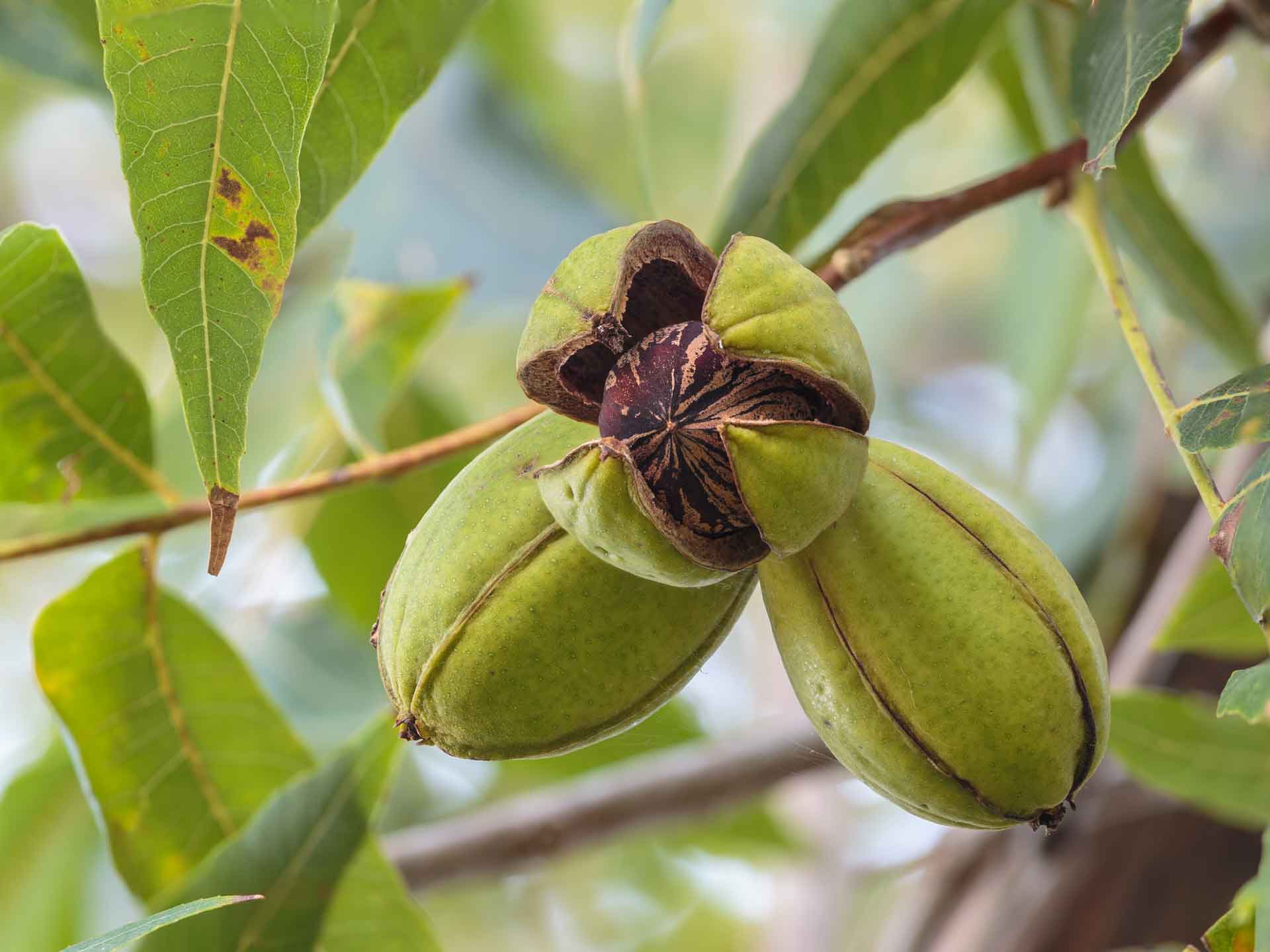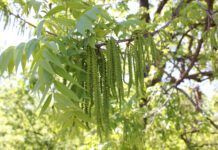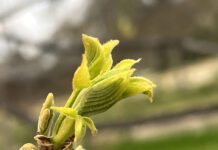Pecan trees may look healthy, but still experience nutrient deficiency or toxicity when lacking in essential micronutrients.
Josh Sherman, University of Arizona Cooperative Extension horticultural advisor, in a presentation on essential micronutrients in pecan production, noted that ‘hidden hunger’ phase is where yields and profits are lost.
Micronutrients
Micronutrients are considered essential to plant health when the plant cannot complete its life cycle if the element is deficient, when the element cannot be replaced by another element and when the element is directly involved in the nutrition of the plant.
Micronutrients, except for boron, are mostly trace metals. They are found in leaf tissue in much smaller amounts that macronutrients usually reported in parts per million (PPM). They are iron, copper, zinc, nickel, manganese and boron.
In pecan trees ‘hidden hunger’ occurs when a micronutrient is within the deficient level, but the tree is not showing signs of deficiency, and it is not performing at optimal level.
Tree Nuts as Storage Units
Tree nuts, according to Ron Byford of New Mexico State University Plant Sciences department, serve as storage units on the tree. They store minerals as well as the carbohydrates, oils, amino acids and proteins needed to sustain respiration, germination and to maintain the seedling until it has produced enough leaf area to be self sufficient.
Environmental stresses can cause developing nuts to drop from the tree, but premature shedding can also be due to lack of nutritional support of the embryo. Genetics play a part in eventual mature nut size, but nutritional status is also a factor.
During the last six seeks of nut fill, most of the storage materials are transferred to the nuts from nearby leaves and shoots. This movement can result in a serious drain on the tree’s nutrient reserves.
With micronutrients in pecans, it is all about enzymes, carbon and timing.
Iron
This mineral functions as a component of electron transport in respiration. Excess manganese and copper can cause iron deficiency. Symptoms of iron deficiency include interveinal chlorosis of young leaves with sharp distinction between veins and interveinal areas. Overwatering trees worsens the problem.
Copper
Functions include electron transport of Photosystem I, enzymes in photosynthesis and detoxification of free radicals.
Visible symptoms of copper deficiency are rare, but include shoot dieback, interveinal chlorosis,bleached young leaves and dwarfed leaflets.
Excess nitrogen can cause copper deficiency, too.
Boron
Boron plays an important role in the movement of carbohydrates across cell walls and in the stability of the pollen germ tube. In adequate boron levels can cause the germ tube to rupture, reducing fertilization. Leaf symptoms of boron deficiency are rare in the southwest. They are seen when leaf boron is less than 15 ppm. Normal growth is observed at 15-50 ppm.
Boron toxicity is a concern. Soil applied boron will generally remain for one year as it can be rapidly leached by irrigation or rainfall. Calcium, potassium and zinc compete with boron for uptake. Monitoring leaf levels for all four is recommended.
Zinc
Zinc has a major influence on yields due to its effect on flowering, fruit size, leaf efficiency and nut yield. It is also important in leaf expansion and shoot elongation. Zinc must be available during those specific times. Even with adequate soil levels of zinc, availability depends on soil conditions. Deficiency symptoms include curling of young leaves, rosette patterns and shoot dieback. Sherman noted that new flushes of growth on pecan trees should receive a foliar application of this nutrient. Applications in the fall are ineffective. Zinc moves slowly in the soil and ground applications may take a year to be effective.
Manganese
This nutrient has a vital role in plant photosynthesis, capturing light energy and biosynthesis of chlorophyll. Manganese deficient trees will have pale color leaves and interveinal chlorosis along with necrosis of very young leaves. Toxic levels of manganese will cause delayed bud break and poor early development. Trees may defoliate then regrow large size leaves.
Nickel
This micronutrient is critical in nitrogen movement and enzyme reactions in plants. Its complete functions are not fully known. Nickel deficiencies disrupt primary and secondary metabolism, affecting early spring growth and natural defenses against pests and diseases. The most common sign of nickel deficiency is a growth abnormality in pecan trees called mouse-ear.
Sherman said in his presentation that one of the most important limiting factors for pecan trees growing in alkaline calcareous soils is the availability of the micronutrients. Though much research has been done on the function of micronutrients, their interactions are very complex and applications of one micronutrient will affect the availability of another.
Growers should send leaf samples annually in July-August to determine micronutrient concentrations for pecan production in their specific location. If foliar micronutrient applications have been done in the orchard, growers should request an acid wash of leaves prior to analysis.
Foliar and Soils
Soil interaction plays a role in the availability of micronutrients, Sherman said. As soil Ph increases, micronutrient availability decreases. The alkaline and calcareous soils found in southwestern pecan growing regions can affect availability of iron, manganese, zinc and copper.
Certified crop advisor Richard Kreps said he finds that quicker adjustments can be made with foliar applications of micronutrients, but trees must be well hydrated prior to application. Kreps added that studies show some micronutrients like iron will see a 7:1 ratio of better uptake over soil applied nutrients. Much of that has to do with pH, soil texture, irrigation practices and water quality. In addition, with foliar applications, many growers never check their final tank pH when mixing sprays and just follow label instructions. Different water quality levels, pesticides, fungicides and adjuvants can drastically affect the final pH of a solution, further hindering nutrient uptake.
Kreps also stressed that soils play an important role in micronutrient uptake.
Soils with low cation exchange capacity, sandy soils, low organic matter and sterile soils will not hold the micronutrients as well especially if they are applied in big irrigation sets. The micronutrients applied in shorter pulse shots with time to absorb in the shallow feeder root zone. Soils with high carbonates, bicarbonates, calcium and phosphates especially in the poly form can tie up micronutrients as well. Glyphosate plays a key role in tying up manganese, so heavy weed pressure with respective herbicide applications can reduce that nutrient’s availability significantly.

Cecilia Parsons
Cecilia Parsons has lived in the Central Valley community of Ducor since 1976, covering agriculture for numerous agricultural publications over the years. She has found and nurtured many wonderful and helpful contacts in the ag community, including the UCCE advisors, allowing for news coverage that focuses on the basics of food production.
She is always on the search for new ag topics that can help growers and processors in the San Joaquin Valley improve their bottom line.
In her free time, Cecilia rides her horse, Holly in ranch versatility shows and raises registered Shetland sheep which she exhibits at county and state fairs during the summer.
















